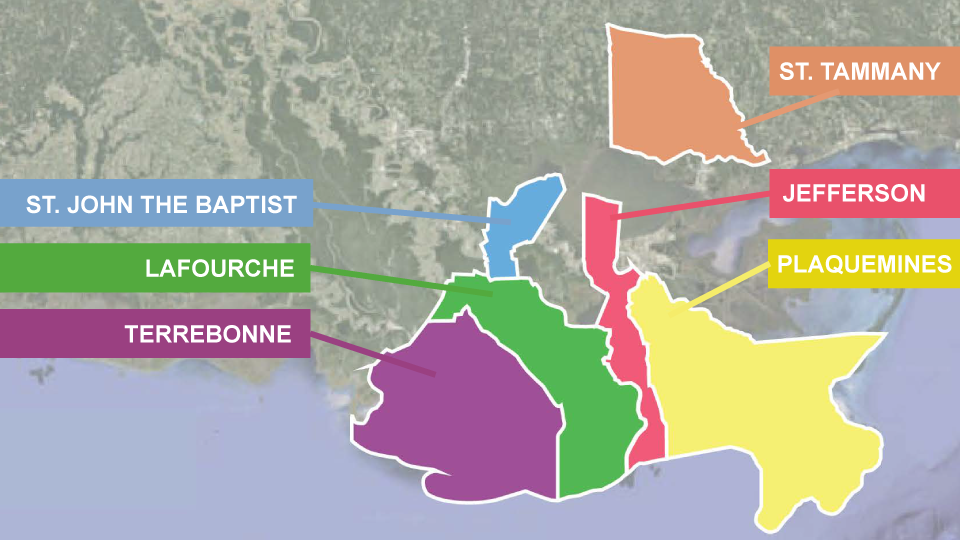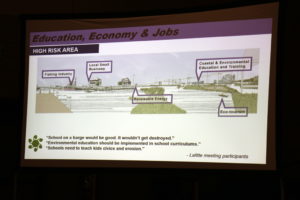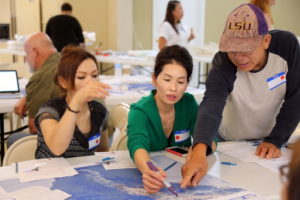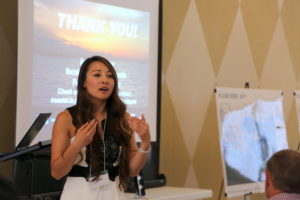Co-Design Process Overview
LA SAFE introduced a ground-breaking approach to community adaptation planning that seeks to address the challenges of coastal degradation, land loss and increasing flood risk in direct partnership with the communities who are most impacted by those challenges. We recognize these coastal trends impact our environment and sustainability, our economies and jobs, and our communities and culture. To prepare for a more resilient future, we created a planning process that integrates planning expertise, science, and most importantly, community members across the coast who are experiencing these challenges firsthand. Our process relied on grassroots input from start to finish.

Is your parish not one of our target parishes?
Project Timeline
Below is a design illustrating the LA SAFE project timeline and the meeting process. Through larger parish-wide meetings and smaller community discussions, our LA SAFE team worked with residents across all six parishes to set design goals for the desired outcomes that they wish to see in their community. As the planning process moved along through the 2017 calendar year, the LA SAFE team worked with residents to achieve new milestones that advanced the work needed to produce a final strategy. In each of the discussions had with community members, the LA SAFE team presented the work that had been done up to the current point - work that was inspired and driven by input at the community level from the previous meeting - and asked them, “Is this correct? Is this what you are seeing in your community? Does this make sense?” In the final iteration of the LA SAFE process the team presented to the community a final adaptation strategy that was crafted with residents along every step of the way.

See What You’ve Missed
We brought the best land loss and flood risk modeling data in the world from our partners at the Coastal Protection and Restoration Authority (CPRA). Alongside an exceptional team of public sector, philanthropic, non-profit and private sector partners the team worked with residents to understand what the goals, needs, and opportunities are in their parishes and individual communities.
Residents described challenges, strengths and opportunities for the future.
505 participants | 2,000 distinct ideas
The first round of meetings included six community meetings, one in each of the six pilot parishes. The LA SAFE team shared information on historic land loss over the last 50 years as well as expected land loss in the next 50 years even with full implementation of the Coastal Master Plan. The team also discussed projected increased flood risk that results from the loss of our wetland buffer and the migration trends taking place across the LA SAFE region. As Louisianans have made the decision to relocate, we have seen resources for everyday services such as education, infrastructure and healthcare shift accordingly.
During roundtable discussions, groups of six to eight residents talked about the ways they have seen land loss impact their environment, economies and communities. They also discussed what they think are the most important aspects of their communities that need to be protected as well as their hopes for the future of their parish.
The project team organized all of the comments into strengths, challenges and opportunities.
Parishwide Meeting Summaries
We held 21 meetings at 19 locations within the six pilot parishes. Residents recommended short-term, medium-term and long-term strategies according to projected low, moderate and high flood risk across LA SAFE parishes.
551 participants | 3,300 distinct ideas
The second round of LA SAFE meetings focused on conversations in smaller communities. These meetings occurred in 19 specific towns and places suggested by residents in the first round of meetings. Three of the meetings were for non-English speaking communities. These smaller meetings allowed the team to present a more in-depth view of the social, environmental and economic trends in each community, and to conduct a more focused conversation about adaptation strategies to address increased flood risk.
The LA SAFE team identified the most discussed topics from the first round of meetings, and created nine question card topics sorted into three categories: Economy & Jobs, Environment & Sustainability and Community & Culture. At the meeting, residents discussed one topic from each category, and placed ideas on the map provided. For each card, residents described short-term (within 10 years), medium-term (within 25 years) and long-term (within 50 years) solutions for adapting to future land change and increased flood risk. Looking 50 years back and 50 years forward, residents discussed the challenges and opportunities for themselves, their children and grandchildren, and for future generations to come.
In this series of 21 community meetings, residents pinpointed challenges, proposed solutions and collectively described a future across different types of environments and varying levels of risk. The project team combined their ideas and mapped proposed strategies. These community recommendations will form the basis for the projects, programs and policies that LA SAFE pursues. The project team used these ideas, current and future environmental risk and best practices in planning as the basis for the round 3 meetings.
Community Meeting Summaries
We returned to each parish with a broad vision of what our coastal communities could look like, including more specific visions for communities according to low, moderate and high flood risk. Residents evaluated these visions and prioritized more detailed strategies in table discussions.
350 participants | Residents prioritized 120 of the top ideas from the previous community meetings.
The third round of LA SAFE meetings occurred across seven different meeting locales. One of the seven meetings was held for a non-English speaking community. This third round of parish-wide meetings allowed the team to present a general idea of what each parish, and the communities that make those parishes great, could look like through future improvements and implementations.
At these meetings, the project team presented potential programs, policies, and projects that began rising to the top based on previous conversations with community members. During this time the project team presented an overall vision based on the contributions from three different sources: (1) the ideas residents presented at previous community meetings, (2) current and future environmental conditions, and (3) the best practices in planning and design.
At the meetings, residents engaged with the project team in two distinct ways. First, as the team presented the potential vision to the community, the residents had the opportunity to weigh in on both general concepts that could go into the future vision as well as the future vision itself. With real-time polling software given to all meeting participants, residents showed their preference for concept ideas and also told the project team whether they agreed with the future vision of their community. Second, members of the community engaged with the project team on a tabletop activity. The goal of the table activity was to provide the residents a chance to approve potential programs, projects, and policies as well as offer insight on why they did or did not agree with the future vision as it was presented by the team. Residents used stickers to indicate which strategies are the best fit for their parish and added more ideas and comments using sticky notes.
Parishwide Meeting Summaries
Download the printable version of the Parishwide Meeting Round 3 Takehome Packet.
In this fourth round of engagement, residents had the opportunity to review and provide feedback on the draft strategies developed by the LA SAFE team after several rounds of collaborative meetings over the course of the year. These draft strategies were presented in a variety of settings included focused discussions with participants from previous meetings, including public and elected officials; casual open-house gatherings; and table presentations at local festivals and other public spaces. The planning team has taken these final suggestions into consideration as they completed the design of the potential adaptation strategies for each parish that addresses challenges and opportunities unique to that parish.
Community Meeting Summary
In this fifth round of engagement, residents had the opportunity to offer their preference on the final product of our collaboration together, learn more about what is next for their parish’s adaptation strategy and celebrate everyone’s hard work with music, art, food and other staples of your parish’s diverse culture.
During our fifth and final round of meetings, residents also had the opportunity to rank their favorite projects that have come as a result of our work together. Preferences provided by parish residents were a key component in determining which catalytic project or program will be implemented in your parish.
Community Meeting Summary
For more detailed meeting information find your parish below:
Downloadable Resources
2017 Coastal Master Plan
Download the printable version of Louisiana's Comprehensive Master Plan for a sustainable coast.
Download
LA SAFE Policy Framework
We've made our policy framework available for download.
DownloadPlaquemines Resilience Planning Framework
Download the printable version of Plaquemines Parish resilience planning framework here.
Download
August 2017 LA SAFE Community Packet
Download the printable version of the Community Meeting Round 3 Takehome Packet.
DownloadQuick Links
| Jefferson Parish | www.jeffparish.net |
| Lafourche Parish | www.lafourchegov.org |
| Plaquemines Parish | www.plaqueminesparish.com |
| St. John the Baptist Parish | www.sjbparish.com |
| St. Tammany Parish | www.stpgov.org |
| Terrebonne Parish | www.tpcg.org |


























